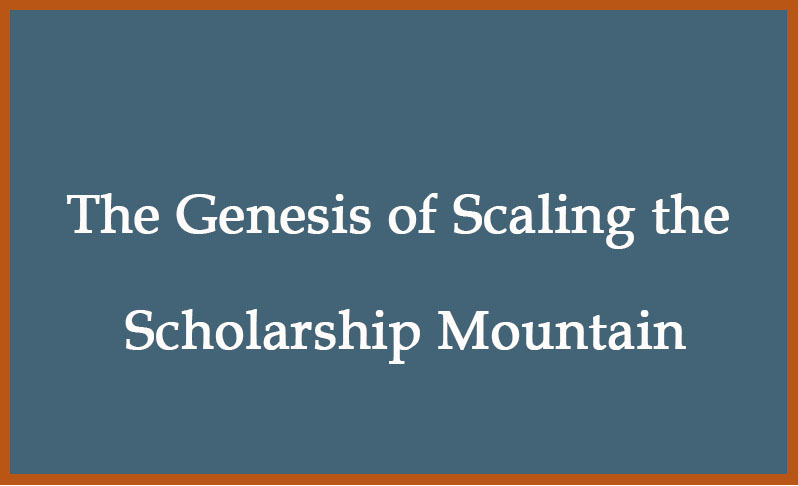In the past few years we have found ourselves writing about a book per semester. This semester, however, we’ve done at least two. We say at least because we’ve always got more than one going, and whereas the semester has a definitive end when you are faculty, for writers it never does. When the fall semester started, for instance, we were finishing up a novel as Quinn MacHollister, one of our collabo-writing configurations, and just last week Where There’s Fire appeared on Amazon. On October 3 we started writing our sixth novel in the Clement County Saga, something we hope to finish for the holidays. And we sent out a Call for Submissions for the tenth book in our “It Works for Me” series, It Works for Me with SoTL, which we will finish in the early spring.
Scaling the Scholarship Mountain
And in the second week of the fall semester, our frequent collaborator, Bill Phillips—see Achieving Excellence in Teaching (AET) (2014)—dropped into our office and suddenly announced he’d like to write another book with the three of us (Charlie, Hal, and I). Since stepping down as dean of our College of Education, Bill has returned to teaching. In fact, he uses the aforementioned AET as the textbook in his EDL 830 College Teaching course. His college had been discussing the possibility of creating a certificate program in higher education and needed another course. Last semester I had facilitated a professional learning community on SoTL, so we immediately suggested the college’s course pick up on the second of the professorial trinity—teaching, scholarship, and service. But, Bill pointed out, such a course wouldn’t have a natural text. Easy, we said, as we had with AET, we could just write the textbook for the class.
Isn’t it amazing how the ideas just pop out of our mouths with no thought about how much work writing such a book would be or how many irons we have in the fire? In fact, with all the irons we have in the fire, we probably ought to be blacksmiths. A few years ago Hal and Charlie had done two books in the “It Works for Me” series on scholarship—It Works for Me as a Scholar-Teacher (2008) and It Works for Me: Becoming a Publishing Scholar/Researcher (2010)—so, after the initial impulse simply to write, they were a bit hesitant te retrace the same path.
Related Reading: “It Works for Me” Series
Developing the Idea
The more the four of us (Charlie, Hal, Bill, and I) discussed the potential for a book on scholarship, the more we began to see the possibilities. For one, the two books in the “It Works for Me” had offered random tips without seeing the whole scholarly process as a journey with definite steps. Our first attempt at a title to focus our thoughts was Climbing the Scholarly Staircase. As you can tell from our blacksmith analogy a paragraph ago, we love metaphors to guide our thinking and writing, and, in fact, in our Introduction to Applied Creative Thinking (2012), we had devoted an entire chapter to metaphor as one of our so-called “nifty nine” creative strategies.
The problem with the staircase metaphor was that while it suggested the process of scholarship, it didn’t indicate the tremendous amount of effort becoming a scholar takes. But every project needs a working title, so we went with it, even developing a temporary Table of Contents.
The next step in our project was to write an introduction that captured the essence of what we want to say. After a brainstorming session (another nifty nine creative strategy), we took a two-pronged approach. From our notes Bill would write a “Preface” and Charlie would tackle the “Introduction.” When those two documents were drafted, we looked them over. In his “Preface” Bill had begun very personally, describing his twin related hobbies of hiking and mountain-climbing.
Still, we ended up constructing two more chapters before we noticed a pattern emerging (you guessed it—recognizing pattern is still another of our nifty nine creative strategies). We kept coming back to mountain climbing.
Related Reading: One Activity To Develop 9 Creative Thinking Strategies
Revision
At that point we stepped in and rewrote everything to conform to our scaling the mountain metaphor. Why did that metaphor work? To be a mountain climber takes preparation, training, starting with small hills, and mostly hard work. We had our metaphor, and we have as of this date 81 pages written.
Will we finish before our holiday deadline? We thought that an easy mark to hit, but then Bill told us before Thanksgiving he had to go . . . you guessed it . . . mountain climbing. Hopefully he comes down that mountain not with tablets a la Moses, but two chapters would be nice.
Author
 Dr. Russell Carpenter is director of the Noel Studio for Academic Creativity and Program Director of the Minor in Applied Creative Thinking at Eastern Kentucky University. He is also Assistant Professor of English. Dr. Carpenter has published on the topic of creative thinking, among other areas, including two texts by New Forums Press. In addition, he has taught courses in creative thinking in EKU’s Minor in Applied Creative Thinking, which was featured in the New York Times in February 2014. Meet Russell.
Dr. Russell Carpenter is director of the Noel Studio for Academic Creativity and Program Director of the Minor in Applied Creative Thinking at Eastern Kentucky University. He is also Assistant Professor of English. Dr. Carpenter has published on the topic of creative thinking, among other areas, including two texts by New Forums Press. In addition, he has taught courses in creative thinking in EKU’s Minor in Applied Creative Thinking, which was featured in the New York Times in February 2014. Meet Russell.



